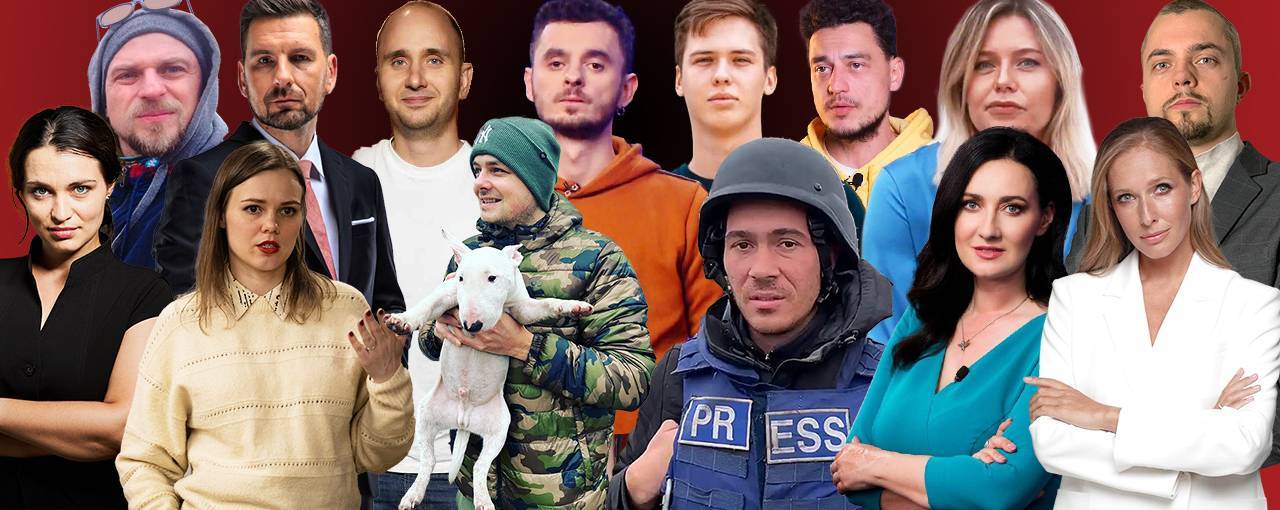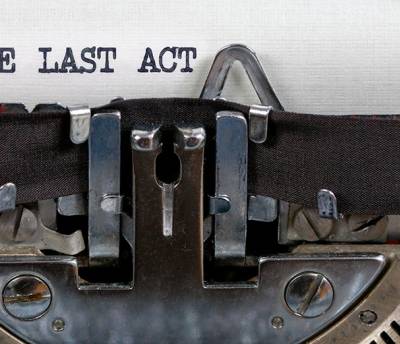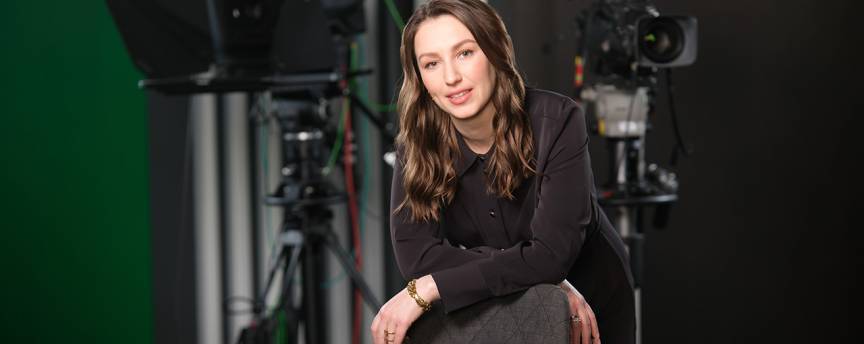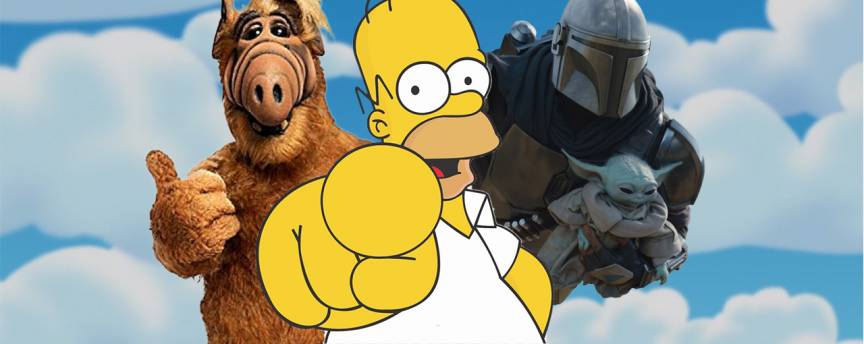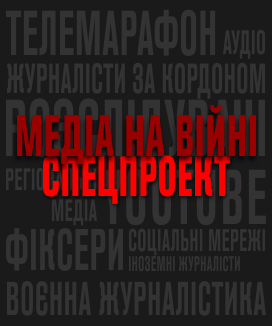The documentary series Media at War: Transformation premiered on the ICTV2 channel, examining how the full-scale war has transformed the media landscape. Produced by FILM.UA Television, the series covers various forms and functions of media, including television, YouTube, social networks, war journalism, radio, foreign media, and more. Each episode features three heroes or editorial teams united by a common theme, sharing their experiences during the full-scale invasion, reflecting on their personal and professional transformation, and analyzing the role and impact of media in this war.
The new realities in which Ukrainian media finds itself, along with the entire country, are not just different working conditions: the topics, heroes, tools, messages, goals, and even the language of the media space have changed. Media has become a powerful weapon in the information war, equally effective in the hands of experienced professionals and newcomers. "Ukrainians on the front lines and in the rear heroically resist, directing all their forces towards victory. And Ukrainian media is at the forefront of this resistance, simultaneously shaping and reflecting the new demands of society. Therefore, by exploring the changes in Ukrainian media, we can understand how Ukrainian society as a whole has changed," says project producer Olesya Lukyanenko. We talked about this transformation and the work on the documentary series, which lasted almost a year, on the eve of the premiere.
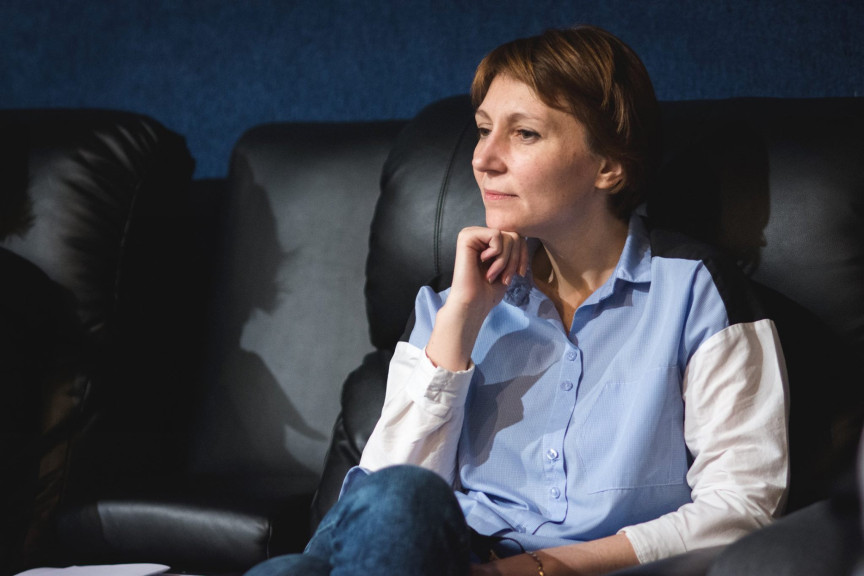
"Prior to the full-scale invasion, in a previous chapter of our lives, we won the PITCH.UA competition with a project centered around journalists. The intention was to create a game series that would explore the inner workings of a newsroom and the media industry as a whole, with the main character investigating various stories," explains Olesya. "In March 2022, representatives from USAID approached us and inquired about producing the series, expressing their desire to support previously successful projects. Initially, I was taken aback and thought, 'How can we possibly consider game series now?' However, I soon realized the potential for a documentary project about the media, given the enormous changes taking place here and now, and we were keen to document them. As the PITCH.UA grant only covered script development, not the full-scale production of a series, I suggested adapting the project into a documentary format.
When planning this project, we decided it would be beneficial to showcase various types and directions of media, with a specific focus on their transformations. The objective was to document the changes that occurred during the full-scale invasion, in various editorial offices, publications, projects, or individual people within the media. However, this task was not easy: within the scope of a relatively small project – 10 episodes of 15 minutes each – and with a modest budget, we aimed to capture the overall picture of a vast transformation. Therefore, our selection of characters and themes is, to some extent, subjective and constrained by the opportunities we had during the war.”

The producer is discussing a process that involves selecting topics and types of media that have undergone a significant transformation, as perceived by the authors. At the onset of the full-scale invasion, numerous newsrooms shifted to round-the-clock broadcasting, with journalists stationed in their offices without any indication of when they would be able to leave. A considerable number of media professionals with no military experience ventured to the front lines or served as fixers, aiding foreign journalists in reporting on the conflict in Ukraine. The social significance of media escalated rapidly, with fierce competitors teaming up, popular bloggers adapting their content to address the demands of the war, and volunteers contributing to the cause. Ukrainian YouTube and podcasts experienced a surge in popularity, and media professionals felt an intense need for Ukrainian content in Ukrainian language, prompting them to quickly adapt their work accordingly. Each of these changes served as the theme of the Media at War: Transformation project.
"In the documentary series, there are more than 30 featured individuals, and naturally, we couldn't capture everything we had planned due to physical constraints," admits Lukyanenko. "For instance, some of the heroes we intended to interview went to fight in the war, or it was tough to contact them due to frequent assignments, as in the case of war correspondents. Obtaining permission to film from large international media outlets working in Ukraine wasn't always feasible, even if their representatives on the ground agreed to collaborate with us. There were times when filming abroad fell through, and some heroes backed out at the last minute due to an overwhelming workload. Nevertheless, we managed to accomplish everything we had set out to do. Even if the cast of heroes changed, the replacement was always relevant, as we selected those who, in our opinion, had undergone the most significant transformations."
Summary of each episode in brief.

The first episode explores the transformation of television through the lens of the "United News" marathon, which has continuously aired 24/7 on the largest TV channels in Ukraine since the beginning of the full-scale war. The hosts, journalists, and producers of 1+1, ICTV, and the public channel Pershyi – Solomiya Vitvitska, Natalia Nahorna, Vadym Karpiak, Oksana Dyhnich, Yevheniy Aharkov, and Andriy Dikhtiarenko – discuss how Ukrainian-language broadcasters set aside competition and joined forces to support citizens and convey the truth about events in the country. They also shed light on the development of rules for working in wartime and give a glimpse behind the scenes of the marathon.
"In the early weeks of the full-scale war, there was a pressing need for information – to know what was happening in the country and nearby," remarks Olesya. "It was a frightening time, and that's when the 'United News' marathon began 24-hour broadcasting. I believe it not only informed but also provided psychological relief to many people, demonstrating that the country was standing strong and resisting the occupiers."

The second episode is dedicated to content creators working in the Ukrainian segment of YouTube. The full-scale war became a defining point for the development of this segment, as the audience, previously scattered among numerous channels (including Russian or Ukrainian Russian-speaking ones, oriented towards views from post-Soviet countries), felt the need for Ukrainian-language content from Ukraine, which caused a sharp increase in domestic channels. At the same time, most content creators changed their themes and formats of work, supporting the information front and helping the audience survive the war. For example, sports journalist Roman Bebekh (Bomber), who was previously focused on football, now tells stories about Ukrainian soldiers, Yevhen Synelnykov (UkrYoutubeProject) explores transformations in the country, and Toronto TV streams have already become a classic example of saving viewers' psyche through humor.
"After the full-scale invasion, many bloggers with huge audiences switched to Ukrainian and maintained their popularity. Others started creating content related to the war and gained a significant following. They recognized the demand and responded as best they could," the producer explains. "For instance, Toronto TV continued to provide its trademark humor through evening streams during the war's early weeks, when we first learned of the mass killings and numerous casualties. This presentation style actually saved many people, including my friends and colleagues. Max Scherbyna made an interesting observation in our film about the changes. He noted that the Toronto TV authors completely avoided the topic of Russia before the invasion, believing it didn't deserve coverage in their episodes. However, after the invasion, they had no other option but to talk about the damned Russia."

The episode about media working in audio format was named “Second Wind” for good reason. After the full-scale invasion began, communication and electricity were cut off, and people were forced to hide in basements or get stuck in long traffic jams. In these circumstances, radio was perhaps the only reliable source of information. Later on, podcasts joined the battle on the information audio front and have since been responding to the demands of Ukrainians who are in search of their identity and need help reflecting on complex issues. Poplava deserves a special place on this list. Although it is not strictly a podcast (in essence, it is an audio stream on Twitter), it was recognized as the best Ukrainian podcast of last year. It has performed an essential mission by explaining what is happening on the front to its listeners.
"One of our heroines, Alla Koshlyak, who is a host at Radio NV, shared a story about acquaintances who were trapped in the occupied territory, spending several weeks hiding in a basement," says Olesya Lukyanenko. "They managed to get a radio receiver which was their only source of information at that time. Interestingly, in the early days of the war, podcasts were not listened to because it was deemed dangerous. People needed to be aware of their surroundings. However, after a few months' break, Ukrainians not only began listening to podcasts but also supported Ukrainian and Ukrainian-language projects which soared to the top, overtaking the previously dominant Russian content."

While the majority of Russian bloggers with a large online audience decided to remain silent since the beginning of the full-scale war, the majority of Ukrainian celebrities have used social media to fight on various fronts. The heroes of our next episode are TV host Kateryna Osadcha, influencer Igor Lachenkov, and skeleton racer Vladyslav Heraskevych, whose activities during the war provide a perfect example of utilizing social media for this purpose. Kateryna Osadcha uses social media to search for missing Ukrainians (which later turned into the TV project Find Your Own on "1+1"). Igor Lachenkov created a Telegram channel (with over a million subscribers) where he publishes verified news and raises millions for the army. Vladyslav Heraskevych actively fights against the presence of Russian athletes in international competitions and manages his own charitable foundation.

While the work of influencers, bloggers, and those same television presenters may be highly visible, Ukrainian fixers represent an invisible yet equally important front. These individuals not only assist foreign journalists with organizing filming, transportation, and translation, but also indirectly influence their reporting by providing context, identifying heroes, and shaping a nuanced view of Ukraine. In this episode, we hear from documentary filmmaker Andrii Lytvynenko, Kharkiv publication Gwara Media editor Serhii Prokopenko, and translator Hanna Kyrienko, who share their experiences, the risks they face, and the essential skills required for their work.
"While producing the episode on fixers, we discovered that for many foreign war correspondents, our war is simply an easy way to make money or gain professional recognition. They rely on "war porn" – people who cry, rape victims, and the like. However, for Ukrainians, this war has invaded our homes. Those who understand the importance of presenting an accurate picture of what is happening here (at least the fact that our Western partners are supporting us with weapons) have become fixers. This is one of the reasons why we were able to win the information war from the early days of the invasion," the producer reflects.

In the episode featuring fixers, viewers will gain insight into the role of foreign war correspondents (as they typically work alongside fixers), and in the following segment, they will learn about the work of "civilian" foreign journalists in Ukraine through interviews with them. Andrew Kramer (USA), the head of The New York Times' Ukrainian bureau, freelance correspondent Francis Farrell (Australia), and journalist Massimiliano Melley (Italy) from MilanoToday, discuss the standards that international publications adhere to and how the portrayal of Ukraine and the Russian-Ukrainian war has evolved in Western media over the past eight years.

When discussing the transformation of television, the documentary series' authors highlighted regional channels that have evolved from being merely local news broadcasters to becoming a vital source of information and a tool for coordinating urgent needs. Journalists from these regional media outlets are often the first to arrive at the sites of missile strikes, intimately understand the peculiarities of their region, and share their experiences of living through military events with their audience. Some of these journalists even worked during the occupation, transforming their own home basements into makeshift television studios, or repurposing entertainment projects into shows that raise funds for the army. While it would be impossible to cover all regions of the country in one episode, the project focused on three editorial offices: broadcasting company Trostyanets in the Sumy region, TV channel MART in Mykolaiv, and broadcasting company 1Zahid in Lviv, showcasing the exemplary work of regional media in conditions of occupation, proximity to the front lines, and in the rear.

No project on media during wartime would be complete without discussing war correspondents. Their work is invaluable, often dangerous, and deserves a separate episode. What knowledge does one need to have to make a quality report from the frontline, while preserving their own life and not interfering with the military? What distinguishes the Russian-Ukrainian war from other wars, and why do journalists choose this direction? Marian Kushnir (Radio Svoboda), Yevhenia Podobna (Suspilne), and Stanislav Kozliuk (Babel) tell their stories.

The penultimate episode of the documentary series explores the work of Ukrainian journalists abroad: how they counter Russian propaganda, which still holds sway in some countries, and how effective this fight is.
"There is a stark contrast in the way Western journalists and ordinary people perceive Ukraine and its war," says Olesya. "A good example is Italy: in an episode about foreign journalists, Italian Massimiliano Melley gives a fairly accurate assessment of events, while his fellow citizens believe Russian propaganda, of which there is a lot in Italy, en masse. We were lucky to find a very interesting heroine, journalist Khrystyna Suvorina, who has been living in Italy for several years and is holding the information front there: she appears on TV shows, joins Italian talk shows where other participants, having listened to Russian propaganda, tell wild things (for example, that Azovstal is a staged plant). She consistently proves the opposite, using factual information, analytics, and examples – trying to break the distorted views created by Russian propaganda. Khrystyna says that there are journalists in Italy who refuse to participate in broadcasts where their opponents will be adherents of Russian propaganda. So she does the opposite: she goes on air, explains, proves, and sees it as her mission. Another interesting example (also the heroes of this episode) is the Polish publishing house Symvol, where Poles and Ukrainians work. It would seem that Poland, which helps us the most and understands us the best since both countries have suffered from Russia for many years. However, even there, many people did not distinguish between Ukrainians and Russians, thinking that we are one nation, and did not care about the war that has been going on since 2014.
In many of our episodes, we discuss the idea that we have lost the information war since the beginning of Russian aggression against Ukraine. For eight years, Russian narratives have been spread worldwide, and despite the efforts of many journalists, we could not overcome them. However, since the beginning of the full-scale invasion, Ukrainians are now winning the information war. We are highly active and strong on the information front, and our efforts are yielding results."

The last episode, which is still in the works, is dedicated to investigative journalism. Unfortunately, Russians commit hundreds of crimes on Ukrainian territory every day: mass shelling, torture of civilians, and deportation of children. And even with the active cooperation of Ukrainian prosecutors with foreign colleagues, it may take years before those accused of the genocide of Ukrainians will stand trial, so journalists are actively involved in investigations. The heroes of the episode are independent investigators who, prior to the full-scale war, specialized in corruption, business intelligence, or explanatory journalism, and today they help de-anonymize war criminals, collect evidence of their activities, and debunk Russian propaganda fakes.
"The media became much more responsible, mature, and aware during the war. Even Western journalists realized that their work here had a significant impact," summarizes the producer. "Ukrainian media, like society, felt the desire to understand who we are, where we're going, and what we need, and began to respond to this demand. At all levels – society, media, army – there was such consolidation that it felt like a single organism. A great example is the investigators, social media, volunteering, and fundraising efforts. I don't know of any other nation that actively raises money for the army and other needs that arise during the war. We're all working towards victory and preserving ourselves as a nation and state. Perhaps that's why there has been such a growth in maturity and responsibility. You understand very well what is at stake."

Olesya is just as enthusiastic about the creative team of the project as she is about the series' heroes: "We have assembled a fantastic team. It includes Dmytro Kochnev, with whom FILM.UA has previously worked – he directed Borscht; journalist Yuliya Kozyryatska, who also worked on Borscht and the I am a Doctor project; Oksana Chyzh – the author of documentary series about classical musicians; Mykola But, who has worked on travel projects, including Oryol i Reshka, and is also known as a writer. Anastasiia Rakhmanina was a great help to us in terms of themes, heroes, and editing in general – we have previously worked together on two successful podcasts. And I also want to mention Sergiy Demydov – our executive producer, with whom we have also created many projects."
Following the airing of the episodes on ICTV2, they will gradually become available on the FILM.UA YouTube channel. Meanwhile, at MBR, we are launching a special partnership project where we will share materials that didn't make it into the videos. This link will feature plenty of exclusive content about the work of journalists during the war, so make sure not to miss it.

